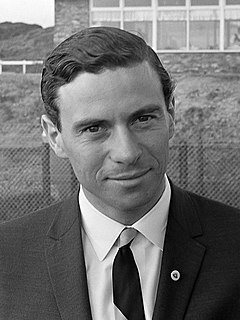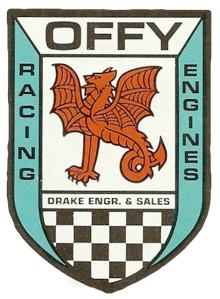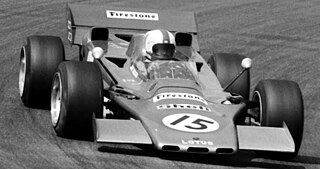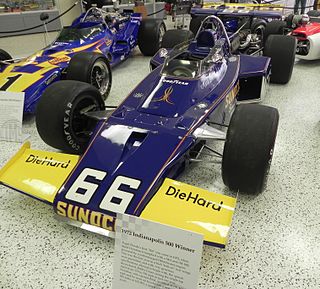
James Clark Jr. OBE was a British Formula One racing driver from Scotland, who won two World Championships, in 1963 and 1965. A versatile driver, he competed in sports cars, touring cars and in the Indianapolis 500, which he won in 1965. He was particularly associated with the Lotus marque.
Quincy David "Quin" Epperly was an American racing car constructor. He was born in Floyd, Virginia, to John Wesley and Iowa Texas Epperly. After completing a correspondence course in "Theory of Aircraft Construction", Epperly moved to Southern California in 1940 to work for Lockheed and Pacific Airmotive. During the war, he joined the Coast Guard Reserve to spend evenings after work on watch at the Wilmington Coast Guard Patrol Base.
Michael Henderson Spence was a British racing driver from England. He participated in 37 Formula One World Championship Grands Prix, debuting on 8 September 1963. He achieved one podium, and scored a total of 27 championship points. He also participated in numerous non-Championship Formula One races, as well as sports car racing.

The Offenhauser Racing Engine, or Offy, is a racing engine design that dominated American open wheel racing for more than 50 years and is still popular among vintage sprint and midget car racers.

James Hurtubise was an American race car driver who raced in USAC Champ Cars, as well as sprint cars and stock cars. He was from North Tonawanda, New York. Hurtubise enjoyed a lot of success in sprint cars, champ dirt cars, and stock cars but never achieved the success at the Indy 500 that his rookie qualifying run promised when he out qualified pole sitter Eddie Sachs by three mph, nearly breaking the 150 mph mark. "Herk" was a fan favorite throughout much of his career because of his fun-loving attitude and his hard driving style.

Rufus Parnell "Parnelli" Jones is an American former professional racing driver and racing team owner. He is notable for his accomplishments while competing in the Indianapolis 500 and the Baja 1000 desert race. In 1962, he became the first driver to qualify over 150 mph. He won the race in 1963, then famously broke down while leading the 1967 race with three laps to go in a turbine car. During his career as an owner, he won the Indy 500 in 1970–1971 with driver Al Unser, Sr.

The 49th International 500-Mile Sweepstakes was held at the Indianapolis Motor Speedway in Speedway, Indiana on Monday, May 31, 1965.
This article discusses the year-by-year history of the Indianapolis 500 race.

The 52nd International 500 Mile Sweepstakes was held at the Indianapolis Motor Speedway in Speedway, Indiana on Thursday May 30, 1968. For the second year in a row, one of Andy Granatelli's STP Turbine-powered machines was leading late in the race, but once again, it failed within sight of victory.

The Lotus 38 was the first rear-engined car to win the Indianapolis 500, in 1965, driven by Jim Clark. It was run by Lotus at Indianapolis from 1965 to 1967; a total of 8 were built, most for use by Lotus, but several were sold for use by other drivers, including A. J. Foyt and Mario Andretti.

The Lotus 56 was a gas turbine-powered four-wheel-driven racing car, designed by Maurice Philippe as Team Lotus's 1968 STP-backed entry in the Indianapolis 500, replacing the successful Lotus 38 and the 1967 STP-Paxton Turbocar. The 4WD concept was also used in the 1969 Lotus 63 F1 car, and the wedge shape became a prominent feature of the world championships winning Lotus 72. As Lotus 56B, a modified version designed by Maurice Philippe and Colin Chapman, the gas turbine car returned in Gold Leaf colours at a few 1971 Formula One events.

The 56th 500 Mile International Sweepstakes was held at the Indianapolis Motor Speedway in Speedway, Indiana, on Saturday, May 27, 1972. The race is notable in that for the first time, the cars were permitted bolt-on wings, and speeds climbed dramatically. Bobby Unser won the pole position at a then-remarkable speed of 195.940 mph (315.3 km/h) for four laps, breaking Peter Revson's track record of 178.696 mph (287.6 km/h) from 1971 by 17.244 mph (27.8 km/h) – the largest one-year track record increase in Indy history. The race average speed of 162.962 mph (262.3 km/h) was also a new record, which stood until 1984.

The 62nd 500 Mile International Sweepstakes was held at the Indianapolis Motor Speedway in Speedway, Indiana on Sunday, May 28, 1978. Danny Ongais dominated the early stages of the race but eventually dropped out with a blown engine. Al Unser Sr. dominated the second half, and held a large lead late in the race. However, Unser bent the front wing of his Lola during a pit stop on lap 180, causing his handling to go away over the final twenty laps. Second place Tom Sneva charged to catch Unser's crippled Lola but came up 8 seconds short at the finish line – the second-closest finish in Indy history to that point. Unser held off the challenge, and became a three-time winner of the 500. It was Al Unser's third Indy victory in the decade of the 1970s, and the fifth of nine overall victories by the Unser family.

The 53rd International 500 Mile Sweepstakes was an auto race held at the Indianapolis Motor Speedway in Speedway, Indiana on Friday, May 30, 1969. It was the third round of the 1969 USAC Championship Car season. Polesitter A. J. Foyt led the race in the early stages, looking to become the first four-time winner of the 500. Near the halfway point, however, a lengthy pit stop to repair a broken manifold put him many laps down. Despite a hard-charging run towards the end, he wound up managing only an eighth-place finish, 19 laps down. Lloyd Ruby, a driver with a hard-luck reputation at the Speedway, was leading the race just after the midpoint. During a pit stop, he pulled away with the fueling hose still attached, ripped a hole in the fuel tank, and was out of the race. The incident put Mario Andretti in the lead for rest of the way.

The 47th International 500-Mile Sweepstakes was held at the Indianapolis Motor Speedway in Speedway, Indiana on Thursday, May 30, 1963.

The 45th International 500-Mile Sweepstakes was held at the Indianapolis Motor Speedway in Speedway, Indiana on Tuesday, May 30, 1961. For the first time since 1949, the Indianapolis 500 was not recognized on the World Championship calendar. The race celebrated the 50th anniversary of the first Indy 500 in 1911.
The Novi engine is an American dual overhead cam supercharged V8 engine used in racing cars in the Indianapolis 500 from 1941 to 1966. Designed by Bud Winfield and Leo Goossen, it was built by Fred Offenhauser in suburban Novi, Michigan, near Detroit.

The Indianapolis Motor Speedway Museum is an automotive museum on the grounds of the Indianapolis Motor Speedway in Speedway, Indiana, United States, which houses the Indianapolis Motor Speedway Hall of Fame. It is intrinsically linked to the Indianapolis 500 and Brickyard 400, but it also includes exhibits reflecting other forms of motorsports, passenger cars, and general automotive history. In 2006, it celebrated its 50th anniversary. The museum foundation possesses several former Indianapolis 500-winning cars, and they are regularly rotated onto the display floor exhibits.

The STP-Paxton Turbocar was an American racing car, designed by Ken Wallis as the STP entry in the Indianapolis 500. Rufus Parnell, who raced under the name "Parnelli Jones," drove it in the 1967 event. After leading for much of the race, a transmission failure with only eight miles left ended the run. It crashed during qualification for the 1968 race; the damage was not fixed and the car ended its career.
Leo William Goossen was a draftsman, mechanical engineer and automobile designer. He is known for his work with Harry Miller and his long involvement in the design and ongoing development of the four-cylinder Offenhauser ("Offy") racing engine.














